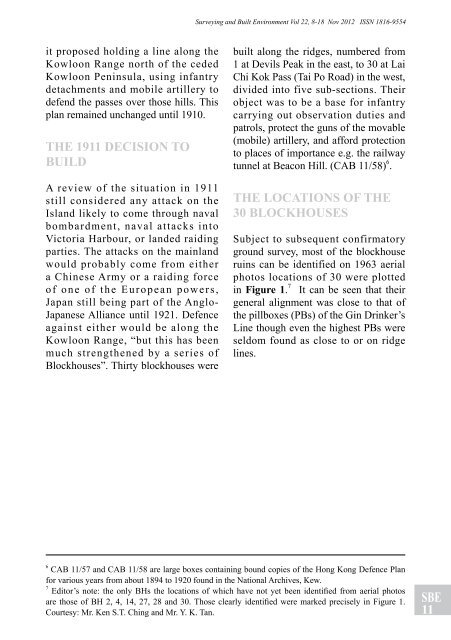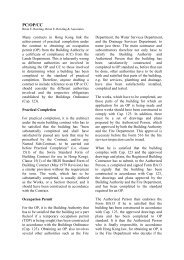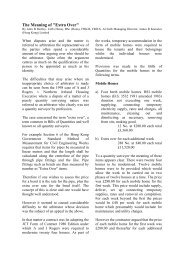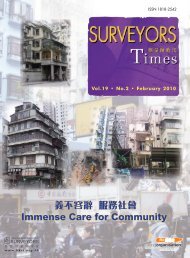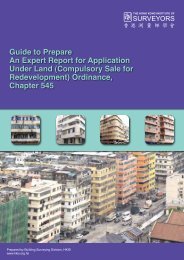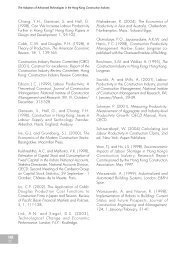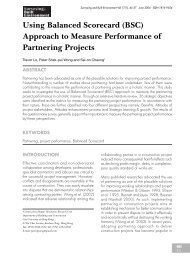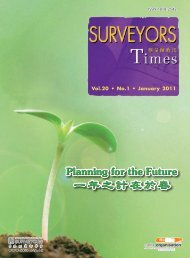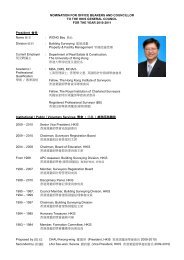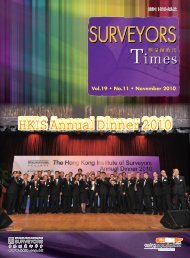Surveying & Built Environment Vol. 22 Issue 1 (December 2012)
Surveying & Built Environment Vol. 22 Issue 1 (December 2012)
Surveying & Built Environment Vol. 22 Issue 1 (December 2012)
You also want an ePaper? Increase the reach of your titles
YUMPU automatically turns print PDFs into web optimized ePapers that Google loves.
it proposed holding a line along the<br />
Kowloon Range north of the ceded<br />
Kowloon Peninsula, using infantry<br />
detachments and mobile artillery to<br />
defend the passes over those hills. This<br />
plan remained unchanged until 1910.<br />
THE 1911 dECISIoN To<br />
BuIld<br />
A review of the situation in 1911<br />
still considered any attack on the<br />
Island likely to come through naval<br />
bombardment, naval attacks into<br />
Victoria Harbour, or landed raiding<br />
parties. The attacks on the mainland<br />
would probably come from either<br />
a Chinese Army or a raiding force<br />
of one of the European powers,<br />
Japan still being part of the Anglo-<br />
Japanese Alliance until 1921. Defence<br />
against either would be along the<br />
Kowloon Range, “but this has been<br />
much strengthened by a series of<br />
Blockhouses”. Thirty blockhouses were<br />
<strong>Surveying</strong> and <strong>Built</strong> <strong>Environment</strong> <strong>Vol</strong> <strong>22</strong>, 8-18 Nov <strong>2012</strong> ISSN 1816-9554<br />
built along the ridges, numbered from<br />
1 at Devils Peak in the east, to 30 at Lai<br />
Chi Kok Pass (Tai Po Road) in the west,<br />
divided into five sub-sections. Their<br />
object was to be a base for infantry<br />
carrying out observation duties and<br />
patrols, protect the guns of the movable<br />
(mobile) artillery, and afford protection<br />
to places of importance e.g. the railway<br />
tunnel at Beacon Hill. (CAB 11/58) 6 .<br />
THE loCATIoNS of THE<br />
30 BloCKHouSES<br />
Subject to subsequent confirmatory<br />
ground survey, most of the blockhouse<br />
ruins can be identified on 1963 aerial<br />
photos locations of 30 were plotted<br />
in figure 1. 7 It can be seen that their<br />
general alignment was close to that of<br />
the pillboxes (PBs) of the Gin Drinker’s<br />
Line though even the highest PBs were<br />
seldom found as close to or on ridge<br />
lines.<br />
6 CAB 11/57 and CAB 11/58 are large boxes containing bound copies of the Hong Kong Defence Plan<br />
for various years from about 1894 to 1920 found in the National Archives, Kew.<br />
7 Editor’s note: the only BHs the locations of which have not yet been identified from aerial photos<br />
are those of BH 2, 4, 14, 27, 28 and 30. Those clearly identified were marked precisely in Figure 1.<br />
Courtesy: Mr. Ken S.T. Ching and Mr. Y. K. Tan.<br />
SBE<br />
11


